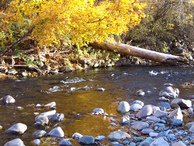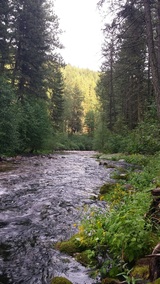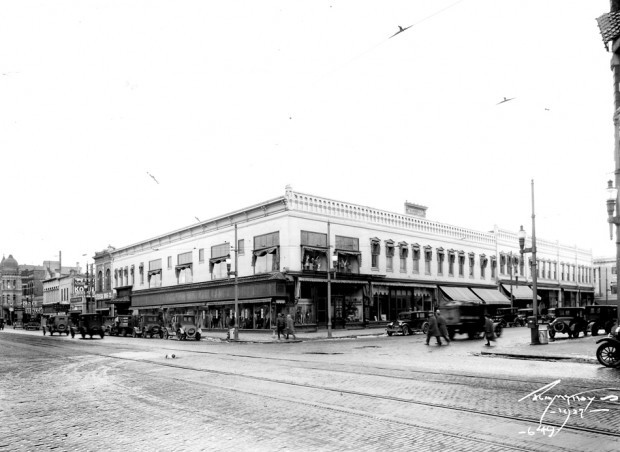 Mark Masenko Photography
Mark Masenko Photography
Let’s take a look at that today and see if we can learn anything about this current lawsuit against Mountain Water, and its chances for success.
The First Water in Missoula
 Missoula's Rattlesnake Creek
Missoula's Rattlesnake Creek
Nothing much happened after that. “One-Eyed Riley,” an Indian that used a donkey and a cart to haul water out of Rattlesnake Creek, was the first person to have seen the potential for infrastructure, surely. When he got going is anyone’s guess, but by 1858 William T. Hamilton had plunked down his trading post sometime over the fall of 1858.
Hamilton was a half-Scottish, half-Indian U.S. Army scout that’d been sent out toward eastern Montana to check out a supposed Indian uprising. Things must have settled down there, for he returned and built a cabin and the trading post and started selling liquor to the men building the Missoula Mills ditch.
By 1865 Hamilton had had enough of the area and moved to Fort Benton, a still-thriving commercial river port at that time. The men building the Mullan Road would have come through just a few years before that, although Rattlesnake Creek wouldn’t see its first bridge until 1869.
Water Works Hill
By 1871 some pipes made of logs and mains made of wood were installed, and things started moving. Missoula Mercantile Company had started in the 1870s on Front Street under different names, becoming the ‘Merc’ in 1885 when it was reorganized and recapitalized with $300,000.
Eventually the Merc bought up the plant near Rattlesnake Creek and named it the Missoula Water Company, also installing an electric plant, probably in the late-1890s.
In 1924 the Water Works Hill diversion dam was replaced by a concrete dam. During those same Roaring Twenties, Missoula Mayor William Beacom urged citizens to gain control of their water, and suggested a purchase price of $600,000. The public flatly refused.
Montana Power Moves In
In 1935 an additional five wells were added to the existing infrastructure, as Rattlesnake Creek just couldn’t meet the demands of Missoula anymore, something not surprising since the population had risen to 14,657 by the 1930 Census.
Mountain Water of California

Park Water owned the water infrastructure – really, what we call the water company – and that in turn was owned by a man named Henry (Sam) Wheeler.
The whole reason that this man Sam Wheeler in California owned the water company was because Montana Power Company sold it to him in 1979. Yep, that’s back when they were still regulated, so that means the Public Service Commission (PSC) had to approve that deal.
Why on earth did they approve that deal if Missoula owning its own water was such a good idea?
Missoula Mayor William E. Cregg “went to the City Council to inquire what they thought,” Missoula City Attorney Jim Nugent told the Ravalli Republic in 2011, remembering his first years starting out in Missoula, “but before he got back to Montana Power, [they'd] sold it to Sam Wheeler in California without notice.”
The First Mountain Water Eminent Domain Case

Missoula had to have that water, however, as events in 1983 made clear to many. In 1983 the Rattlesnake Creek was taken out of the system entirely, and would remain just an emergency back-up source for water. Now the Missoula Aquifer would be used, and it supplies more than 40,000 residents each day.
The whole reason that Rattlesnake Creek was shifted wasn’t really because of demand, however – it was supplying just 45% of the city’s needs – but because of giardia, a parasite that can cause serious diarrhea and vomiting.
At the time, the City of Missoula accused Mountain Water of knowing about this giardia problem for two years before doing anything about it, and only then when there was an outbreak. The reason? Probably the $4 to $5 million cost to fix things, although the State Board of Health later gave them a thumb’s up on their handling of the situation.
The giardia debacle still fresh in peoples’ minds, the city tried to buy Mountain Water the following year, in 1984, and failed miserably. With the 1984 proceedings, the company was valued at $11 million and Missoula proposed a bond of $17.5 million to make the purchase, build some more infrastructure, and have some cash in reserve for problems ($2 million). Mountain Water’s general manager at the time, Lee Magone, disputed that valuation and said the company was worth $16 million.
Many thought the purchase a good idea, but many didn't, including ten residents that got a voter initiative to block the deal. The City of Missoula sued them and lost. Feeling spurned, Missoula Mayor John H. Toole – someone that’d been appointed on December 12, 1983, and was never once elected – began eminent domain proceedings against Mountain Water.
To show he was serious, Mayor Toole decided to bow-out of the primary election in favor of campaigning on this issue, a political mistake if there ever was one.
To bolster his actions, Mayor Toole got an initiative on the ballot in September 1985, and the people of Missoula voted to support the eminent domain acquisition. “I remember campaigning door to door, and some people were very adamant about it,” Jack Reidy, who’d run for the Missoula City Council in 1985, told the Ravalli Republic in 2011.
Can the blame for this be placed at Sam Wheeler’s feet? Could he have done more to prevent that giardia outbreak, and thus the turning of public opinion against his company? Would the $5 million have been justified then? We’ll never know.
Voters headed to the polls on September 10 and approved the initiative 4,006 to 3,475. Missoula would be suing Mountain Water. Toole was also out - Robert E. Lovegrove would begin serving as mayor in January, 1986.
The eminent domain case came to trial in March, 1986, and lasted 4 days. The case never saw a jury, just the Fourth Judicial District Court's Judge Robert M. Holter. The ruling came down in August – the city “had failed to prove that the condemnation was necessary.” Missoula had lost again, and created untold amounts of ill-will with Sam Wheeler and Mountain Water employees.
Mountain Water in the 2000s
 Rattlesnake Wilderness
Rattlesnake Wilderness
By the mid-2000s, Mountain Water controlled 37 wells, 45 boosters, 24 storage facilities, and could manage a whopping 9.34 million gallons of water. Considering that the average Missoula water bill is $47.35 a month and that there’s 22,000 Mountain Water customers in Missoula…that means the company is making $1,041,700 a month.
I’m guessing a lot of that’s profit, and perhaps that’s why Mayor Engen is so adamant about getting this water company – it’ll give him more play money.
Hey, I agree that Missoula owning its water is a good idea – so long as we have smart people in city government to run it (and I'm not talking about into the ground) – but we don’t have the money to buy it.
Sometimes I see something online or at Shopko that I want to buy. Since I’m a poor writer, I usually don’t have the money to buy it, however. So what are my options? I guess I could make a scene because I can’t get the price I want, or I could wait and save up that money and come back to the store and make the purchase when I’m able.
Most small children in Missoula know how this works – they go through it each weekend. Why don’t our elected city officials know it?
You Might Also Like
Mountain Water Company Official Website History
Missoula has never controlled its own water destiny – 2011 Ravalli Republic Article
City of Missoula vs. Mountain Water – 1987 Lawsuit PDF
City of Missoula vs. Mountain Water - 1989 Lawsuit eCases Report
Missoula History Minutes – Water Works Hill & Rattlesnake Creek
Lower Rattlesnake Historic District – National Historic Register Application
Average bill bumps to $47.35 after Mountain Water Co. rate hike – 2014 Missoulian Article
Rattlesnake History - Great Images
Historic Missoula - Photographs of the 1900s



